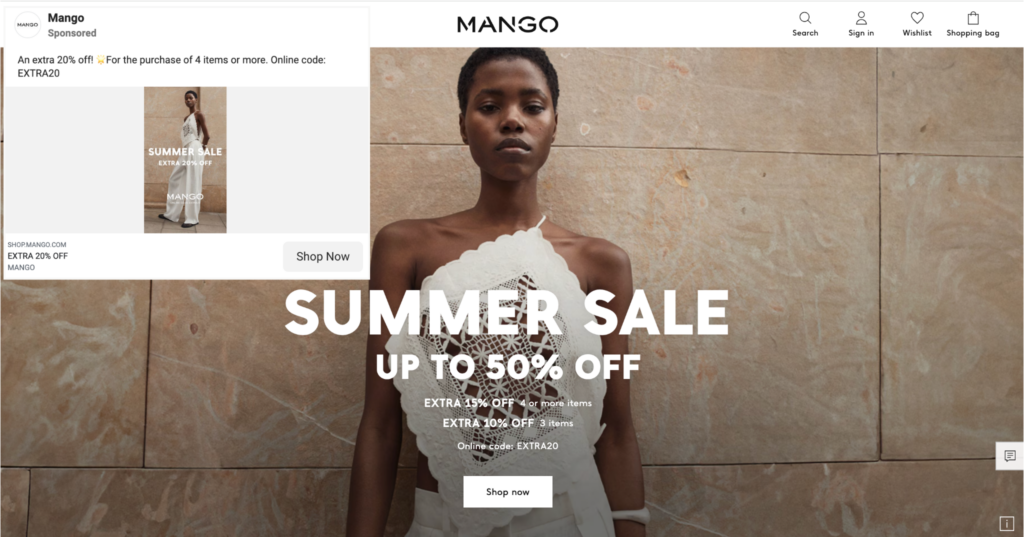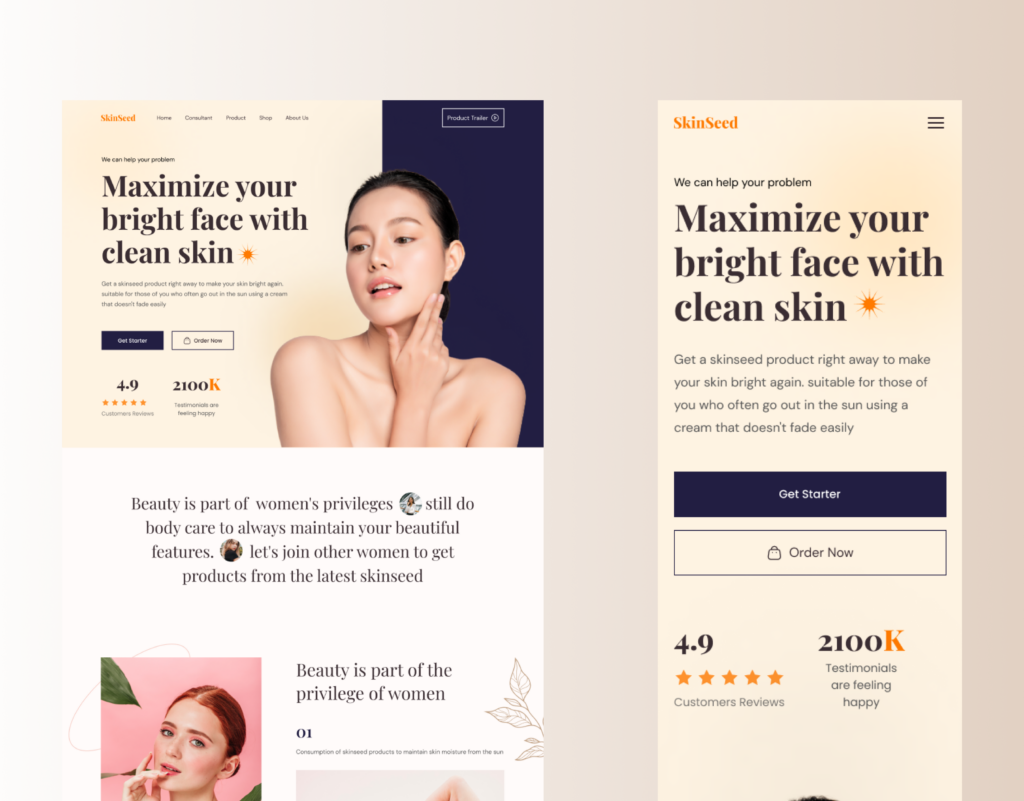You’ve created the perfect Facebook ad for your e-commerce store. The creative is eye-catching, the copy is tight, and you’ve meticulously researched your target audience. The question now becomes: Where should this ad lead potential customers? Choosing the right landing page for Facebook ads is crucial to your campaign’s success.
Let’s dive into the factors you should consider for optimizing landing pages in your e-commerce store when running Facebook ads.
Landing Page for Facebook Ads
In the context of an e-commerce business with the goal of driving purchases, a landing page for Facebook ads is a targeted webpage designed to convert ad clicks into sales.
When creating your landing page for Facebook ads, keep the following in mind:
- Ensure alignment between the ad and landing page
- Simplify the conversion path
- Decide between a product page and a custom landing page
- Use high-quality images of the products
- Implement A/B testing
- Utilize the power of retargeting
- Focus on monitoring and optimization
- Build trust
- Consider mobile users
- Avoid overcomplexity
Alignment between ad and landing page
One of the most fundamental mistakes online sellers make is a disconnect between the ad and the landing page. Imagine clicking an ad for a limited-time offer on a particular brand of sneakers, only to be directed to the homepage of a general sports store. Confusing, right?
A disconnect between the ad and the landing page leads to cognitive dissonance for the user, resulting in lower conversion rates. Psychologically, a consistent experience from ad to landing page helps lower mental barriers to completing a purchase.
Always make sure that your landing page for Facebook ads has the same style, tone, and offer as your ad. This creates a cohesive user experience that can significantly improve conversion rates.
Simplifying the conversion path
The human brain is wired to follow the path of least resistance. Studies on decision fatigue show that the more choices a person has to make, the more the quality of those decisions deteriorates.
Landing pages with multiple offers, links, and buttons can overwhelm visitors, causing decision paralysis. A clean, focused landing page reduces the cognitive load and makes it easier for the customer to follow through with a purchase.
Remove any distracting elements, like unnecessary links, that could divert the visitor’s attention. Make the call-to-action (CTA) buttons large and easy to find.
Product page vs. custom landing page
A 2019 study published in the Journal of Marketing Research found that personalized web experiences significantly impact consumer behavior. Directing a customer to a generic product page may not offer the tailored experience that maximizes conversions.
Custom landing pages allow for a targeted narrative that addresses the unique needs and pain points of the traffic coming from a specific ad, increasing the likelihood of a purchase.
Design custom landing pages for specific campaigns that include additional selling points, testimonials, or other persuasive content. A/B test these against product pages to see which performs better.
Use high-quality images of the products
According to a study by Adobe, 38% of people will stop engaging with a website if the content or layout is unattractive. Low-quality images or poorly written copy can cause potential customers to question the credibility and professionalism of your brand, which in turn decreases trust and sales.


Invest in high-quality product photography and hire a skilled copywriter to craft compelling, clear, and concise copy.
A/B Testing for success
Harvard Business Review has discussed how experimentation is at the heart of any successful business. Without A/B testing, you’re essentially shooting in the dark.
Companies like Amazon and Netflix constantly run A/B tests to fine-tune even the smallest aspects of their user experience, which cumulatively results in substantial gains in conversions.
The “Shop now” button will almost always lead to higher conversion rates compared to the “Learn more”, “Order now” or “Explore” CTA buttons. Users are more likely to purchase after clicking on those buttons - it shows.
The power of retargeting
The Baymard Institute found that the average online shopping cart abandonment rate is nearly 70%. Not all customers who leave your site are uninterested; many need an extra push.
Retargeting keeps your brand and products at the top of their minds, leveraging the psychological principle of the ‘mere-exposure effect’, which increases the affinity for things merely because they are familiar.
Use Facebook’s ad platform to set up retargeting campaigns based on how visitors interact with your landing page. For example, you could retarget visitors who abandoned their shopping carts.
Monitoring and optimization
A renowned management consultant Peter Drucker once said, “If you can’t measure it, you can’t improve it.” Ignoring key performance indicators (KPIs) is like sailing a ship without a compass; you might get somewhere, but probably not where you want to be. Tracking metrics gives you the data needed to make evidence-based decisions.
Regularly check your KPIs such as CTR, conversion rate, and average order value (AOV). Create a landing page for your Facebook ads based on data-driven insights.
Building trust with trust elements
According to Nielsen’s Global Trust in Advertising report, 66% of consumers trust consumer opinions posted online. Incorporating verified reviews and trust badges plays on social proof, a psychological and social phenomenon where people tend to conform to the actions of others under the assumption that those actions are reflective of the correct behavior.
Display verified customer reviews or third-party trust badges on your landing page to instill confidence in potential buyers.
Don’t forget mobile users
A Google study found that 61% of users are unlikely to return to a mobile site they had trouble accessing, with 40% visiting a competitor’s site instead. With an increasing percentage of e-commerce sales happening on mobile devices, neglecting mobile optimization could mean a significant loss of potential revenue.
Make sure your landing page for Facebook ads is fully responsive, and consider creating accelerated mobile pages (AMP) for faster load times on mobile devices.
Avoiding overcomplexity
While it’s tempting to stuff your website with all the bells and whistles technology allows, studies in user experience (UX) design indicate that simpler is often better. Excessive use of pop-ups can lead to “banner blindness,” where users are more likely to ignore these elements, or worse, get frustrated and leave your site.
Additionally, too much JavaScript can slow down page loading times, negatively affecting your SEO rankings and increasing bounce rates.
1. Minimize Pop-Ups: If you must use them, make sure they're purposeful and non-intrusive. <br>
2. Audit Your JavaScript: Excessive JavaScript can lead to slower site speed. Perform regular audits to ensure only essential scripts are running. <br>
3. Prioritize Load Times: According to Google, as page load time goes from one second to ten seconds, the probability of a mobile site visitor bouncing increases by 123%. Use tools like Google PageSpeed Insights to keep track.<br>
4. Test, Test, Test: Keep an eye on metrics like bounce rate and time spent on page after making changes to your website.
Common Mistakes on Landing Pages
However, even the most well-designed ads can fall short if the landing page has issues. To help you maximize your marketing efforts and avoid potential pitfalls, we’ve identified some of the most common landing page mistakes.
One of the most significant pitfalls is having a misleading product page. Since we already covered that one mistake, we’ll focus more on other mistakes that often appear when creating landing pages for your Facebook ads.
Inappropriate Content
One of critical mistake is including inappropriate content on your landing page. This refers to content, products, or services that are prohibited by Meta Advertising Standards. Examples include promoting illegal substances, weapons, or adult content.
Additionally, any content that violates Meta’s guidelines, such as misleading health claims or deceptive financial services, can lead to your ad being disapproved or your account being penalized. Always ensure your landing page content complies with Meta’s advertising policies to avoid these issues.
Pop-up ads or difficult navigation
Pop-up ads and difficult navigation are major turn-offs for visitors. A landing page that contains content interfering with a person’s ability to navigate away from it can significantly impact user experience.
Intrusive pop-ups that are hard to close or appear immediately upon landing can disrupt the user journey. Similarly, complex navigation, where links or buttons are hard to find or use, can frustrate users, making them more likely to abandon the page. Streamlining navigation and minimizing intrusive elements help keep visitors engaged and guide them smoothly toward conversion.
Page not found
A “Page Not Found” error is a surefire way to lose potential customers. This mistake happens when the web page doesn’t work properly or isn’t functional at all. Clicking on the ad might lead to a 404 error or a page that doesn’t exist, resulting in a poor user experience. Non-functional pages that don’t load properly, have server errors or are under construction can also deter visitors.
Regularly checking for broken links and ensuring all landing pages are fully operational is essential for maintaining a seamless user experience and maximizing conversion rates.
Landing Page Based on Marketing Goals
The landing page you choose for your ad campaign is not a one-size-fits-all decision; it’s deeply influenced by your marketing objectives and the unique value proposition of your business. Making the wrong choice can lead to lost opportunities and suboptimal conversion rates.
Single Product Promotion
If your campaign aims to push a specific product, direct the traffic to the product page to eliminate additional clicks and streamline the conversion process.
Collections or Categories
If you’re promoting a category or a collection of products (like a “Summer Sale”), it makes sense to lead traffic to a well-designed Collections Page.
Brand Awareness
When the campaign objective is to introduce your brand or tell your brand story, leading traffic to the homepage or a dedicated “About Us” page can be effective.
Promotions and Special Offers
If you have a time-sensitive promotion, consider creating a dedicated landing page that focuses solely on that offer, making it easier for users to make a quick decision.
Split Test Your Decisions
If unsure, conduct A/B tests to gauge the effectiveness of different landing pages for your specific objectives.
Summing Up
Research indicates that simpler, more coherent user experiences lead to higher conversions and better engagement. Shopify or WooCommerce store owners have the option to land users on different types of pages, depending on their business focus.
If promoting a single product, a dedicated product page can yield the best results, backed by principles of cognitive psychology that advocate for reduced decision fatigue. For those building brand stories, a homepage landing could be more effective, offering a comprehensive view of the business.





